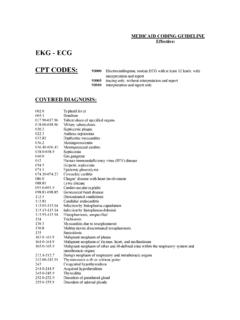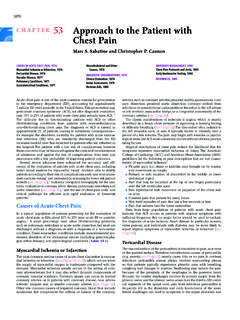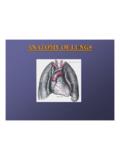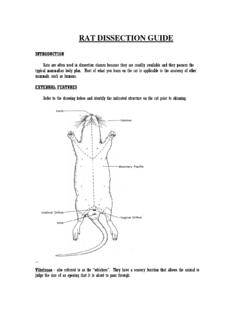Transcription of TNM Classification of Malignant Tumours - 7th …
1 International union against cancer TNM Classification of Malignant Tumours - 7th edition Outline of changes between 6th and 7th editions TNM 7th edition available now! The aim of this presentation is to: present the changes between the 6th and 7th edition Indicate where no changes have taken place provide links to where questions on the use of TNM may be found Special thanks to the editors Dr Leslie Sobin Dr Christian Wittekind Dr Mary Gospodarowicz Highlights Changes to take effect from January 2010 The rules of Classification and staging correspond to those appearing in the seventh edition of the AJCC Cancer Staging Manual 2009 and have approval of all national TNM committees First time the UICC process for evaluating proposals has been used Highlights 9 new classifications 6 major modifications Elimination of MX Introduction of Anatomical Stage Grouping and Prognostic Grouping A continuous systematic approach
2 Composed of two arms has been introduced: procedures to address formal proposals from investigators periodic literature search for articles about improvements to TNM Proposals and results of the literature search are evaluated by members of a UICC panel of experts, the TNM Prognostic Factors committee, the AJCC and the other national TNM experts The changes to Lung cancer staging proposed by the IALSC and adopted are an example of this process First time the UICC process for evaluating proposals has been used TNM-7 New classifications Melanoma of upper aerodigestive tract Gastroesophageal carcinomas Gastrointestinal stromal Tumours (GISTs) Appendix: carcinomas Neuroendocrine Tumours : stomach, intestines, appendix; pancreas; lung Intrahepatic cholangiocarcinoma Merkel cell carcinoma Uterine sarcomas Adrenal cortex TNM-7 Major modifications Esophagus Stomach Lung Skin Vulva Prostate TNM-7 Minor or no modifications Head and neck Small intestine Colon Anal canal Liver, hepatocellular Gallbladder, ampulla, pancreas Mesothelioma, pleural Skin, melanoma Gynecological sites: except vulva Urological sites: except prostate Elimination of MX The use of MX may result in exclusion from staging cMX is inappropriate as the clinical assessment of metastasis can be based on physical examination alone.
3 If the pathologist does not have knowledge of the clinical M, MX should NOT be recorded. It has been deleted from TNM. pMX: does not exist; pM0: does not exist (except at autopsy) Elimination of MX What remains: cM0 = clinically no distant metastasis cM1= distant metastasis clinically, , colon cancer with liver metastasis based on CT pM1= distant metastasis proven microscopically, , needle biopsy If a cM1 ( , liver met) is biopsied and is negative, it becomes cM0, not pM0 Stage Grouping and Prognostic Grouping Stage grouping: Anatomical extent of disease, composed of T, N, and M categories alone Prognostic Grouping: T, N, and M plus other prognostic factors For most tumour sites only the (Anatomical) Stage Grouping is given Nasopharynx 7th edition T1 Nasopharynx, oropharynx or nasal cavity (was T2a) without parapharyngeal extension T2 Parapharyngeal extension (was T2b) T3 Bony structures of skull base and/or paranasal sinuses T4 Intracranial, cranial nerves, hypopharynx, orbit, infratemporal fossa/masticator space N1 Unilateral cervical, unilateral or bilateral retropharyngeal lymph nodes, above supraclavicular fossa; < 6 cm N2 Bilateral cervical above supraclavicular fossa; < 6 cm N3a >6 cm.
4 N3b Supraclavicular fossa Anatomical Stage Groups Stage I T1 N0 Stage II T1 N1 T2 N0, N1 Stage III T1, T2 N2 T3 N0, 1, 2 Stage IVA T4 N0, 1, 2 Stage IVB Any T N3 Stage IVC Any T Any N M1 Stage II compressed Changes from TNM 6 Mucosal Melanoma (upper aerodigestive) 7th ed - (new site) T3 Epithelium/ submucosa (mucosal disease) T4a Deep soft tissue, cartilage, bone, or overlying skin T4b Brain, dura, skull base, lower cranial nerves, masticator space, carotid artery, prevertebral space, mediastinal structures, cartilage, skeletal muscle, or bone STAGE GROUPING Stage III T3 N0 Stage IVA T4a N0 T3-T4a N1 Stage IVB T4b Any N Stage IVC Any T Any N M1 Mucosal melanomas are aggressive Tumours .
5 Therefore T1 and T2 and Stages I and II are omitted TNM-7 Oesophagogastric junction Tumours A tumour the epicenter of which is within 5 cm of the esophagogastric junction and also extends into the oesophagus is classified and staged according to the oesophageal scheme All other Tumours with an epicenter in the stomach greater than 5 cm from the oesophagogastric junction or those within 5 cm of the EGJ without extension into the oesophagus are staged using the gastric carcinoma scheme Oesophagus 7th edition TNM definitions: AJCC = UICC Tis Carcinoma in situ /High-grade dysplasia T1 lamina propria or submucosa T1a lamina propria or muscularis mucosae T1b submucosa T2 muscularis propria T3 adventitia T4 adjacent structures T4a pleura, pericardium, diaphragm, or adjacent peritoneum T4b other adjacent structures, aorta, vertebral body, trachea N0 No regional lymph node metastasis N1 1 to 2 regional lymph nodes N2 3 to 6 N3 >6 [N1 was site dependent] M - Distant Metastasis M1 Distant metastasis [M1a,b were site dependent] Changes from 6th edition Oesophagus 7th edition Anatomical Stage Groups (adeno & squamous)
6 [UICC] Stage IA T1 N0 M0 Stage IB T2 N0 M0 Stage IIA T3 N0 M0 Stage IIB T1, T2 N1 M0 Stage IIIA T4a N0 M0 T3 N1 M0 T1, T2 N2 M0 Stage IIIB T3 N2 M0 Stage IIIC T4a N1, N2 M0 T4b Any N M0 Any T N3 M0 Stage IV Any T Any N M1 Major changes Oesophageal Squamous Cell Carcinoma Prognostic Grouping [AJCC adds type, grade & site] T N M Grade Location Stage IA 1 0 0 1,X Any IB 1 0 0 2,3 Any 2, 3 0 0 1,X Lower Stage IIA 2, 3 0 0 1,X Upper, middle 2, 3 0 0 2,3 Lower Stage IIB 2, 3 0 0 2,3 Upper, middle 1, 2 1 0 Any Any Stage IIIA 1,2 2 0 Any 3 1 0 Any Any 4a 0 0 Any Any Low Stages: AJCC not all = UICC. Stages IIIA,B, C & IV: AJCC=UICC Oesophageal Adenocarcinoma Prognostic Grouping [AJCC adds type & grade] T N M Grade Stage IA 1 0 0 1, 2, X Stage IB 1 0 0 3 2 0 0 1, 2, X Stage IIA 2 0 0 3 Stage IIB 3 (IIA) 0 0 Any 1, 2 1 0 Any Stage IIIA 1, 2 2 0 Any 3 1 0 Any 4a 0 0 Any Stage IIIB, IIIC, & Low Stages: AJCC not all = UICC.
7 Stages IIIB, C & IV: AJCC=UICC Stomach 7th edition T1 Lamina propria, submucosa T1a Lamina propria T1b Submucosa T2 Muscularis propria T3 Subserosa (was T2b) T4a Perforates serosa (was T3) T4b Adjacent structures N1 1 to 2 nodes N2 3 to 6 nodes (was N1) N3a 7 - 15 nodes (was N2) N3b 16 or more (was N3) Changes from 6th edition Stage IA T1 N0 Stage IB T2 N0 T1 N1 Stage IIA T3 N0 T2 N1 T1 N2 Stage IIB T4a N0 T3 N1 T2 N2 T1 N3 Stage IIIA T4a N1 T3 N2 T2 N3 Stages IIIB, IIIC, Stages: most changed Gastrointestinal Stromal Tumours (GIST) 7th ed - new chapter All sites: T1 < 2 cm T3 > 5-10 cm T2 > 2 5 cm T4 > 10 cm StageGrouping - Small Intestine Mitotic rate Stage I T1-2 N0 M0 Low Stage II T3 Low Stage IIIA T1 High T4 Low Stage IIIB T2, 3, 4 High Stage IV Any T N1 M0 Any Any T Any N M1 Any Prognostic factors.
8 Site, size, mitotic rate Stage Grouping - Stomach Mitotic rate Stage IA T1-2 N0 M0 Low Stage 1B T3 Low Stage II T-2 High T4 Low Stage IIIA T3 High IIIB T4 High Stage IV Any T N1 M0 Any Any T Any N M1 Any Carcinoids and Neuroendocrine Tumours Staging GI tract: Carcinoid : separate staging by site Small cell/large cell: stage as carcinoma Pancreas: stage as carcinoma Lung: stage as carcinoma Skin: separate Classification for Merkel cell carcinoma Carcinoids (NET) 7th edition Gastrointestinal Appendix T1 < 2 cm T2 > 2 4 cm; cecum T3 > 4 cm; ileum T4 Perforates peritoneum; other organs, structures Small Intestine T1 Lam propria/ submucosa and < 1 cm T2 Muscularis propria or > 1 cm T3 Jejunal, ileal: subserosa.
9 Ampullary, duodenal: pancreas or retroperitoneum` T4 Perforates serosa; adjacent structures Stomach Tis < mm confined to mucosa T1 Lam propria or submucosa & < 1cm T2 Muscularis propria or > 1 cm T3 Subserosa T4 Perforates serosa; adjacent structures Large Intestine T1 Lam propria or submucosa or < 2cm T1a < 1 cm; T1b 1 to 2 cm T2 Muscularis propria or >2 cm T3 Subserosa, or pericolorectal tissues T4 Perforates serosa; adjacent structures Carcinoids (NET) 7th edition Stage Groups Carcinoid: Appendix Stage I T1 N0 Stage II T2, T3 N0 Stage III T4 N0 Any T N1 Stage IV Any T Any N M1 Very Carcinoid: other GI sites Stage I T1 N0 Stage IIA T2 N0 IIB T3 N0 Stage IIIA T4 N0 IIIB Any T N1 Stage IV Any T Any N M1 similar Appendix 7th edition Carcinoid Carcinoma T1 < 2 cm T2 > 2 4 cm; cecum T3 > 4 cm; ileum T4 Perforates peritoneum.
10 Other organs, structures N1 Regional Stage I T1 N0 Stage II T2, T3 N0 Stage III T4 N0 Any T N1 Stage IV Any T Any N M1 Based mainly on size T1 Submucosa T2 Muscularis propria T3 Subserosa, non-peritonealize periappendiceal tissues T4a Perforates visceral peritoneum/Mucinous peritoneal tumour within right lower quadrant T4b Other organs or structures N1 < 3 regional N2 > 3 regional M1a Intraperitoneal metastasis beyond right lower quadrant M1b Non-peritoneal metastasis Like colon, based on depth; includes goblet cell carcinoid Appendix 7th edition Carcinoma (was part of colon Classification ) Colon - Rectum T4 Tumour directly invades other organs or structures and/or perforates visceral peritoneum T4a perforates visceral peritoneum T4b directly invades other organ or structures M Distant Metastasis: colon M1 Distant metastasis M1a one organ M1b > one organ or peritoneum Changes from TNM 6 Appendix - Carcinoma.





